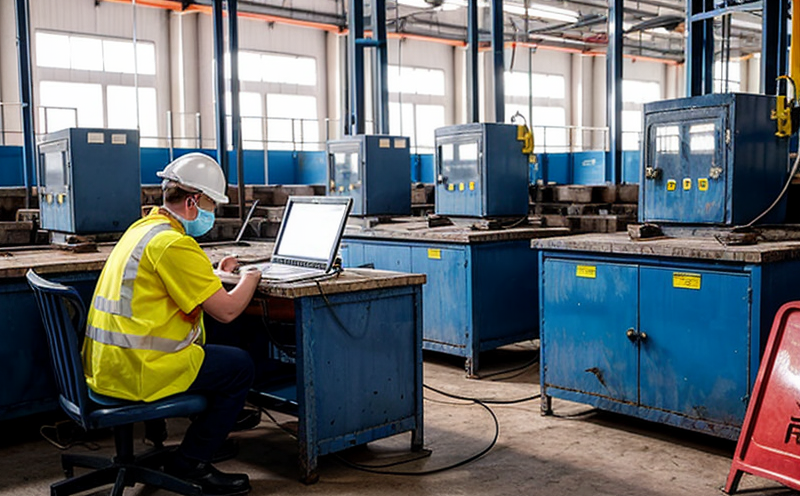ISO 20347 Slip Resistance Testing of Work Footwear
The ISO 20347 standard has revolutionized the way occupational health and safety professionals assess the slip resistance properties of work footwear. This service ensures that the footwear used in industrial environments meets stringent safety requirements, thereby reducing the risk of slips, trips, and falls—leading causes of workplace injuries.
The primary focus is on ensuring the footwear can withstand a variety of conditions encountered in factories and other industrial settings. The test simulates real-world scenarios where employees may encounter wet or contaminated surfaces, making it essential for safety-critical operations such as manufacturing, construction, logistics, and food processing.
The testing procedure involves subjecting footwear to a series of standardized tests that mimic hazardous walking conditions. This ensures the footwear can provide optimal traction under various conditions, helping to prevent accidents and reduce liability risks. The test results are critical for quality managers, compliance officers, R&D engineers, and procurement teams who need to ensure their suppliers meet the highest safety standards.
The ISO 20347 slip resistance test is a multi-step process that involves several key stages:
- Preparation of Specimen: The footwear specimen is prepared according to the standard's specifications. This includes ensuring the correct size and shape, as well as any necessary modifications for consistent testing.
- Initial Testing: Initial tests are conducted on dry surfaces using a standard protocol to establish a baseline for comparison.
- Wet Surface Simulation: The footwear is then tested under wet conditions to simulate real-world scenarios where employees may encounter contaminated or slippery surfaces. This phase assesses the footwear's ability to maintain traction in adverse conditions.
- Contaminated Surfaces: Further tests are conducted on various types of contaminants, such as water, oil, and food residues. These tests evaluate the footwear's resistance to slipping on a range of potentially hazardous surfaces.
- Repetitive Testing: The footwear is subjected to repeated testing to ensure that it maintains its slip-resistant properties over time. This simulates long-term use in industrial environments where conditions may vary.
- Reporting and Analysis: The results of the tests are analyzed, and a comprehensive report is generated. The report includes detailed information on the footwear's performance under different conditions, along with recommendations for improvement if necessary.
The test apparatus used in ISO 20347 slip resistance testing typically includes:
- A walking platform that simulates various walking conditions.
- A system to apply controlled forces and measure the frictional force between the footwear sole and the surface.
- Contaminants such as water, oil, or other substances used in real industrial environments.
The acceptance criteria for ISO 20347 slip resistance testing are stringent. The footwear must demonstrate sufficient traction to prevent slipping on wet surfaces with contaminants, thereby ensuring the highest level of safety for workers.
Understanding the importance of this test is crucial for any organization that prioritizes occupational health and safety. By adhering to ISO 20347 standards, organizations can ensure their employees are equipped with footwear that meets the highest safety standards, reducing the risk of accidents and improving overall workplace safety.
Industry Applications
| Industry Sector | Application |
|---|---|
| Manufacturing | Ensures worker safety in areas with slippery or contaminated surfaces. |
| Construction | Maintains slip resistance on wet and oily surfaces during construction activities. |
| Logistics & Warehousing | Prevents slips and falls on potentially hazardous surfaces in warehouse environments. |
| Food Processing | Guarantees worker safety when handling food products that may contaminate footwear. |
The ISO 20347 slip resistance test is particularly important for industries where workers are exposed to wet or contaminated surfaces. By ensuring the footwear meets these stringent standards, organizations can significantly reduce the risk of accidents and improve overall safety compliance.
Why Choose This Test?
- Regulatory Compliance: Ensures adherence to international safety standards.
- Prioritizes Worker Safety: Reduces the risk of slips, trips, and falls in hazardous environments.
- Informed Decision-Making: Provides data-driven insights into footwear performance under various conditions.
- Enhanced Product Quality: Ensures that work footwear meets or exceeds industry benchmarks for safety and performance.
- Cost-Effective Safety Measures: Prevents accidents, reduces downtime, and minimizes liability costs.
The ISO 20347 slip resistance test is an indispensable tool for organizations that prioritize occupational health and safety. By choosing this test, companies can ensure they are meeting the highest standards of safety and compliance, ultimately protecting their workforce and improving overall operational efficiency.
Competitive Advantage and Market Impact
- Innovation Leadership: Demonstrates a commitment to cutting-edge safety technology, setting the organization apart from competitors.
- Enhanced Reputation: Builds trust with customers by ensuring that work footwear meets or exceeds international standards.
- Avoid Legal Penalties and Liability Claims: Reduces the risk of accidents, thereby avoiding legal repercussions and financial losses.
- Improved Productivity: By reducing workplace injuries, organizations can improve productivity and maintain a healthy workforce.
- Increased Market Share: Demonstrates to stakeholders that the organization prioritizes employee safety and well-being, potentially leading to increased market share.
The ISO 20347 slip resistance test provides a clear competitive advantage by ensuring that work footwear meets the highest standards of safety and compliance. This not only enhances the organization's reputation but also contributes to its long-term success in the market.





